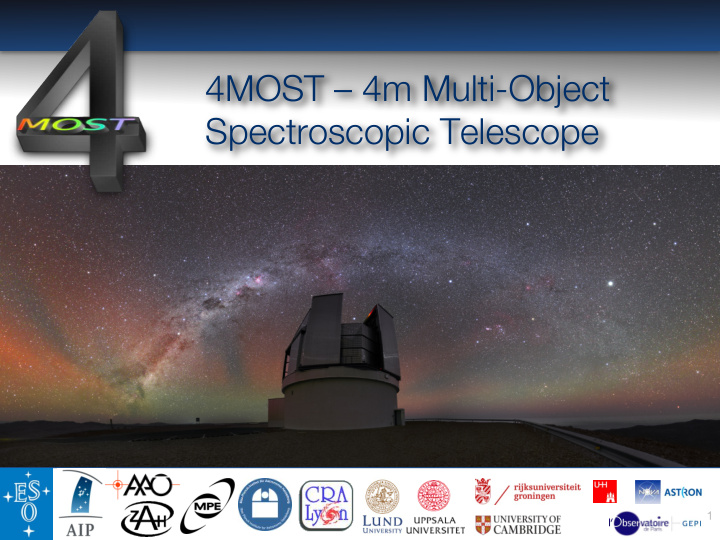



4MOST – 4m Multi-Object Spectroscopic Telescope 4MOST: a Wide-field, high-multiplex optical spectroscopic survey facility for ESO Roelof de Jong, PI (AIP) 15 April 2016 www.4MOST.eu 1
4MOST – 4m Multi-Object Spectroscopic Telescope 4MOST: a Wide-field, high-multiplex optical spectroscopic survey facility for ESO Roelof de Jong, PI (AIP) 15 April 2016 www.4MOST.eu 2
4MOST: Wide-field, high-multiplex optical spectroscopic survey facility for ESO Status: • – ESO Council approved 4MOST in June 2015 – Preliminary Design Review scheduled for June 2016 – Operations start on VISTA telescope 2021 (at least 2x 5 year) Science: • – Cosmology, galaxy evolution, high-energy and Galactic science – Complement large-area space missions: Gaia, eROSITA, Euclid, PLATO – Complement ground-based surveys: VISTA, VST, DES, LSST, SKA, etc. Survey facility: • – Consortium delivers instrument, science operations, data products, science – Run all-sky 5 year public surveys in parallel, with yearly data releases – Key surveys organized by consortium in coordination with community – Add-on surveys from community and Chile through ESO peer-reviewed applications 4MOST Overview | Lyman alpha and Quasar Workshop, 1 February 2016 | Roelof de Jong 3
Background: EU strategic docs A Science Vision for European Astronomy (ASTRONET) • Extreme Universe (Dark Energy & Dark Matter, Black holes) – Galaxy Formation & Evolution – Origin of Stars and Planets – Solar System – ASTRONET Infrastructure Roadmap � • „A smaller project, but again of high priority, is a wide-field spectrograph for massive surveys with large optical telescopes.“ ESA-ESO Working Group on Galactic populations, chemistry and dynamics � • „Blue multiplexed spectrograph on 4 or 8m class telescope“ Strategic Review on Europe’s 2-4m telescopes over the decade to 2020 • (ASTRONET/OPTICON) „Optical wide-field spectrograph on 4m telescopes (N+S)“ 4MOST will play an important role in almost all research areas identified in the ASTRONET Science Vision document 4MOST Overview | Lyman alpha and Quasar Workshop, 1 February 2016 | Roelof de Jong 4
Instrument Specification Specification Design value ~4.1 degree 2 ( ⌀ >2.5°) Field-of-View (hexagon) Multiplex fiber positioner ~2436 Medium Resolution Spectrographs (2x) R~4000–7000 # Fibres 812 fibres (2x) Passband 370-950 nm Velocity accuracy < 1 km/s High Resolution Spectrograph (1x) R~20,000 # Fibres 812 fibres Passband 392.6-435.5, 516-573, 610-679 nm Velocity accuracy < 1 km/s # of fibers in ⌀ =2’ circle >3 ⌀ =1.45 arcsec Fibre diameter >2h x 18,000 deg 2 Area (first 5 year survey) Number of science spectra (5 year) ~75 million of 20 min 4MOST Overview | Next Decade of SN Cosmology Workshop, 14–15 April 2016 | Roelof de Jong 5
4MOST Operations Unique operations model for MOS instruments that allows observations for • most science cases 4MOST program defined by Public Surveys of 5 years • Surveys will be defined by Consortium Consortium and Community Community • All Surveys will run in parallel • – Surveys share fibres per exposure for increased efficiency Consortium Key Surveys Consortium Key Surveys will define observing strategy • – Millions of targets all sky +30 ° J2000 Coordinates, Hamm ff Add-on Surveys for smaller surveys Add-on Surveys • +0 ° 24 H 18 H 12 H 6 H – Small fraction fibers all sky or – dedicated small areas -30 ° GC – 10 3 to 10 6 targets Tiles Per Field Dark Bright 0 0 -60 ° 1 2 2 3 Several passes of sky with 2, 10, 20, 30 mins • 3 5 4 6 SEP 5 8 LMC 6 9 7 11 8 12 4MOST Facility Simulator - O SMC -90 ° Wedding-cake distribution for total time 1h to 10h • 4MOST Overview | Next Decade of SN Cosmology Workshop, 14–15 April 2016 | Roelof de Jong 6
SN research opportunities • Possible transient return using 2% of fibres: – 32 fibres/pointing x 8/night x 150 dark nights ~ 40,000 spectra / year (~8 / degree 2 per pointing ) • Can be live transients or host galaxies • Scheduling 1–7 days in advance (TBD) • Aim for live transients near peak in deep drilling fields? • Use of HR fibres? • Adding science case currently being negotiated (Bob Nichol) • ESO member state institutes/individuals can still join – Individual membership: 100k € + 1 FTE • 1 staff + 1 post-doc + students 4MOST Overview | Next Decade of SN Cosmology Workshop, 14–15 April 2016 | Roelof de Jong 7
Magnitude limits for typical science cases abundances ¡ stellar ¡parameters ¡ stellar ¡radial ¡veloci:es ¡ 2o min limit 2 hour limit redshi-s ¡ 4MOST Overview | Lyman alpha and Quasar Workshop, 1 February 2016 | Roelof de Jong 8
4MOST Overview | Lyman alpha and Quasar Workshop, 1 February 2016 | Roelof de Jong 9
Recommend
More recommend